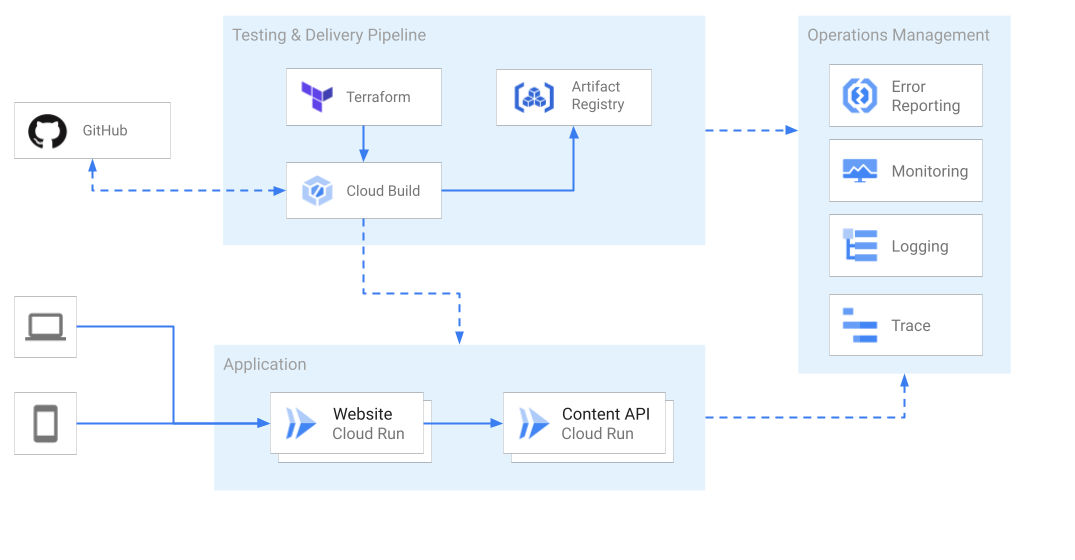Emblem Giving is a sample application intended to demonstrate a complex, end-to-end serverless architecture. It showcases serverless continuous delivery as a donation sample app hosted on Google Cloud.
This sample application is for learning purposes only. Real financial transactions are not made. The giving campaigns in the app are not real.
This project features:
- 2-tier web application architecture with Cloud Run
- continuous delivery with Cloud Build
- Terraform deployment
- Example configuration and usage of the following Google services and apis:
- Cloud Run
- IAM
- Secret Manager
- Cloud Storage
- Cloud Firestore
- Cloud Build
- Artifact Registry
- Pub/Sub
Go deeper into project details in the documentation or read through the technical decisions that got us where we are today.
- Release Stage: Alpha
- Self-service / Independent Setup: Follow the instructions to set up Emblem in the Getting Started section below.
- Become a CONTRIBUTOR!
- Check out our shovel-ready Good First Issues or go a bit deeper in Help Wanted
Emblem is made of a combination of resources created and managed by Terraform and resources created via the Google Cloud CLI or Google Cloud Console. You may deploy Emblem by running setup.sh (see streamlined setup instructions).
To deploy Emblem, you will need:
- 3 Google Cloud projects (ops, stage, prod) with billing enabled on each
- A fork of this repo
The machine that you will run the setup from will need the following installed:
We recommend running through setup steps using Google Cloud Shell, which has the required softare pre-installed. The following will open Cloud Shell Editor and clone this repo:
-
Connect a fork of this Github repo to your Emblem ops project
Connect your repository to your Google Cloud Project via the Cloud Build triggers page in the Google Cloud Console. Make sure you are working from your ops project. This will require you to enable the Cloud Build API and authenticate with your Github account.
gcloud services enable cloudbuild.googleapis.comPrincipals with access to your Google Cloud project will be able to create and run triggers on the repository you use.
-
Set environment variables
The streamlined setup uses
setup.shto deploy Emblem resources via Terraform and thegcloudCLI.Create three environment variables (PROD_PROJECT, STAGE_PROJECT, OPS_PROJECT) with their respective project id's.
export PROD_PROJECT=<YOUR_PROD_PROJECT_ID> export STAGE_PROJECT=<YOUR_STAGE_PROJECT_ID> export OPS_PROJECT=<YOUR_OPS_PROJECT_ID> -
Execute setup.sh
The setup will do the following:
- Create a GCS bucket that will be used to store remote Terraform state files
- Run
terraform applyfrom each of the environment root directories interraform/environments/ - Build and push
content-api,web, andrunnercontainers to the Artifact Registry repositories in your ops project - Seed sample data into the Firestore instances in your staging and prod projects
- Deploy Cloud Run services for
content-apiandwebsitein your stage and prod projects
You will be prompted to enter the URL for the Github repository you added to your ops project in step 1. This will be used to deploy Cloud Build triggers for the CICD pipeline. To begin setup:
./setup.shOnce complete you will have a deployed instance of Emblem.
To see which Google services and apis got installed in your projects, check out below:
LoadingstateDiagram Operations --> Staging Operations --> Production state Operations { state "IAM" as a0 state "Secret Manager" as a1 state "Cloud Build" as a2 state "Artifact Registry" as a3 state "Cloud Firestore" as a4 state "Cloud Scheduler" as a5 state "Pub/Sub" as a6 } state Staging { direction LR state "Cloud Firestore" as b0 state "Cloud Storage" as b1 state "Cloud Run" as b2 state "Cloud Logging" as b3 } state Production { direction LR state "Cloud Firestore" as c0 state "Cloud Storage" as c1 state "Cloud Run" as c2 state "Cloud Logging" as c3 }
This is not an official Google project.

